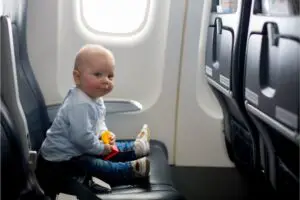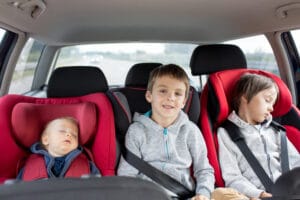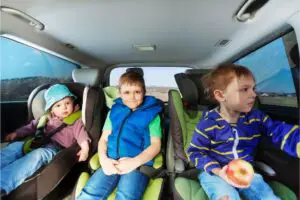If you love to travel but wonder that it can be chaotic to travel with your children as it can get hard to handle things once they start walking with their little feet, you will have to keep an eye on their every move.
But with a car seat, things can get a lot more comfortable.
Now you are probably wondering how to fly with a car seat, especially when you already have to look after the luggage and children at the same time.
Well, as simple as it gets, the airline seats are not designed to fit your children’s tiny bodies, so now multiple airlines allow you to take your car seats with you in the plane that is the appropriate size that matches your child’s height and weight.
Here are 15 things you should know while flying with a car seat:
1. Guardian With Each Car Seat
2. No Booster Seats
3. No Extra Belly Or Loop Belts
4. No Child Vests Or Carriers
5. Placement Of The Car Seats
6. Navigating Through The Plane With The Car Seat
7. FAA Requirements
8. Rear-Facing Or Forward-Facing
9. Do Not Let Your Child Sit On Your Lap
10. Getting Your Car Seats Through TSA
11. Car Seat Sizes And Different Airlines
12. Car Seats As A Luggage
13. If You Are Not Allowed To Take Your Car Seat
14. Flip Your Car Seats
15. You Cannot Store The Car Seat Anywhere Inside The Plane
In this article, I will be providing you with the proper guidelines that you can follow and 15 things you need to know before traveling by car seat. Let’s begin!
Table of Contents
- 1 15 Things You Should Know When Flying With A Car Seat
- 1.1 1. Guardian With Each Car Seat
- 1.2 2. No Booster Seats
- 1.3 3. No Extra Belly Or Loop Belts
- 1.4 4. No Child Vests Or Carriers
- 1.5 5. Placement Of The Car Seats
- 1.6 6. Navigating Through The Plane With The Car Seat
- 1.7 7. FAA Requirements
- 1.8 8. Rear-Facing Or Forward-Facing
- 1.9 9. Do Not Let Your Child Sit On Your Lap
- 1.10 10. Getting Your Car Seats Through TSA
- 1.11 11. Car Seat Sizes And Different Airlines
- 1.12 12. Car Seats As A Luggage
- 1.13 13. If You Are Not Allowed To Take Your Car Seat
- 1.14 14. Flip Your Car Seats
- 1.15 15. You Cannot Store The Car Seat Anywhere Inside The Plane
- 2 Frequently Asked Questions
- 3 Conclusion
15 Things You Should Know When Flying With A Car Seat

It is important for every parent to have a better understanding of the rules and regulations when it comes to traveling with a car seat.
It is also necessary for you to do research before traveling as there are some do’s and don’ts when it comes to flying as some airlines have different procedures and rules that every passenger needs to meet.
So moving on with the article, I have done a thorough research and provided you with a list of 15 things that you must know before so next time you travel, you will not have to face any frustrating situation when traveling by your car seat.
1. Guardian With Each Car Seat
Many airlines expect you to travel with full responsibility for the things you bring along, and when it comes to traveling by car, seats, including your luggage, can make things hard to deal with.
It is stated that when an emergency strikes, it can be a hectic procedure to evacuate people out of the plane.
This is why many airlines suggest that it is important for parents who have more than one car seat to not travel all on their own as it can also be difficult to manage but instead have a guardian for each child and the car seat so the evacuation process can be done rapidly in an emergency.
Moreover, it is suggested that every parent should connect the airline before traveling to let them be aware of your traveling plans with a car seat; it is also necessary to provide you with the information you need to know regarding their airline policies.
2. No Booster Seats
Parents can make simple mistakes such as taking things that are not allowed because they weren’t fully informed or had never done the research for a particular thing, such as taking booster seats.
Indeed, booster seats are not allowed, but it is due to a particular reason, and that is because the airplane seat belts are designed with only lap portion.
Even though some updated premium seats that are designed with lap-shoulder belts would still not allow you to take your booster seats as it cannot be installed on the seat and it does not provide your child with any protection.
However, there’s a solution for you that can actually let you use the booster seat in an airplane, and that is only if you use it in the harness mode.
This is because there will be a sticker on the side of the seat which will read out saying; “This restraint is certified for use in motor vehicles and aircrafts”, this means that it will be FAA approved so you can travel easily anywhere but just show the inspectors the sticker every time.
Do keep in mind, though, that booster seats are not designed to be taken in airplanes like rear-facing car seats are.
3. No Extra Belly Or Loop Belts
This is just another trick that many parents believe will keep their child secure in place without slipping or moving around too much.
These belly and loop belts are commonly used for infants; however, they can be life-threatening if you fasten them around your child’s abdominal area, especially during a crash or high-pressure landings.
The way many people place it is by attaching the belt with the adult seat belt of the airplane and going around the abdominal area of the child.
Research has shown that restraining your child in such a way can cause severe internal injuries.
This is because, during a crash, the forces will move the adult’s body forward, which will tighten the loop belt around the abdominal area.
It is highly dangerous as most people forget with high pressure on the abdomen area as the belt tightens due to crash forces on the belly belts can cause severe internal injuries and your child’s body is still sensitive so it can be life-threatening as well.
4. No Child Vests Or Carriers
I’ve seen many parents carrying their kids in a child vest on the airplane.
This is not the best option for you to do as, firstly, it is not FAA approved as it will not protect your child during turbulence or a crash, and as for airlines, they do not allow the parents to keep their child on carriers in the plane during takeoff or landing.
Moreover, it is also not the best option for you or for your child as it can be really uncomfortable, tiring, and painful to sit on the plane seat for hours.
In addition to that, child vests are particularly designed for you to wear when you are taking your child for a walk or to run errands.
If you wear it to airports, the authorities might make you take it off as it is not in the policy to wear such vests because it does not protect your child.
If you are wearing it during turbulence, it can cause severe head and spinal cord injuries from the seat in front of you.
5. Placement Of The Car Seats
It is an important rule for every parent to know that they are not allowed to place/install car seats closest to the aisle or the middle seat as it can cause disturbance during the evacuation process.
It can also be difficult to pass through for parents if you want to go to the restroom.
This is why you are obligated to install the car seats at the window seat, or if you are flying in a bigger plane and have the middle row seats, then it is appropriate to install the car seat in the middle seat of the middle row as it will make way for people to walk through both sides of the plan easier and during an emergency, your child will be safe and will also be easy for you to take your child out of the seat.
Lastly, airlines do not allow car seats to be installed near the emergency exit rows as it is not safe, and only children above the age of 15 are allowed as the rules and regulations stated by the Federal Aviation Administration.
This can be annoying and difficult to do as you pass through in the plane that barely has aisle space and with people looking for their seats.
It can be challenging as you will find it hard to pass through and might end up hitting someone or something with the car seat as well as the latches can get stuck in with something or someone.
Because of that, the airline staff would ask you to wait until the rest of the passengers are on board and then allow you to make your way to the seat numbers, but that can also get really awkward.
However, some parents have tried this trick that works every time. You can tell the gate agents at the airport that you require extra time to get a car seat with you.
This would actually be good for you because they might let you in early without the pre-boarding policy and help you get situated.
7. FAA Requirements
This is one of the most important aspects to look at before traveling with a car seat as there are some strict rules and regulations that everyone is expected to follow at the airport and on the airplane but in this case, regarding the car seats.
It is necessary for every parent to choose the right car seat size for their child that matches the height and weight limits, and you can adjust the height of the top of the seat whenever you like.
If you take a big car seat, it will not only be difficult to pass it through the plane aisle but also make it difficult to install on the plane seat.
This is why it is important to check the manual instruction set by the manufacturer for the appropriate car seat size and the compatibility of the seat as well as if it is allowed to take in the plane.
And make sure that your seat has complete labelsand the FAA-approved sticker and other stickers that are required before purchasing the car seat.
Some people even prefer taking a flexible car seat that you can fold and unfold easily, so maybe look for a seat like that.
8. Rear-Facing Or Forward-Facing
When you are taking your child out in the vehicle, it is always suggested to keep your child’s car seat in the rear-facing position.
This is because it is the safest way a child can sit and be protected from any serious accidents/crashes.
It is the same for airplanes; you are obligated to place your child’s car seat rear faced and cover the top of the seat for extra protection in case of turbulence or crash or harsh landings.
Moreover, research has shown that in many accidents, children who were sitting forward faced had no chance of survival because of the injuries they faced due to crash forces as there was no protection at all.
It is the parents’ responsibility to place the car seats in the safest way possible and also follow the regulations set by the Federal Aviation Administration.
9. Do Not Let Your Child Sit On Your Lap
There are a number of reasons why this is not the best choice to travel with a child of any age.
The FAA recommended that it is best to always travel by a car seat with you, and if you are taking it in the airplane, it is best to keep your child seated inside the car seat throughout the whole flight and do not take them out as it can put their lives at risk.
The reason why you should not allow your child to sit in your lap while traveling is, it is not the safest option.
There have been multiple research done on this particular way of seating, and many types of research have shown the likely impact that a crash or a harsh landing can have on a child who has not been restrained or the seat belts were adjusted properly.
During a crash landing, there are higher chances of your child getting serious injuries on their sensitive parts of the body or can even take their lives.
You cannot hold your child’s body in your arms during a crash.
Due to high forces, it is likely that your child will fall out of your hands or hit the seat in front of you, causing serious neck, brain, or body injuries.
So always choose the car seats wherever you go.
10. Getting Your Car Seats Through TSA
For safety purposes, it is pretty obvious that everything will have to get through the TSA inspection, and it is an essential step at the airport.
It is important for you to make sure the buckles and the latches are not hanging loose.
Instead, they are placed in the seat where everything can be seen, and make sure to flip your seat over, making it face downward.
This is because if your buckles are loose, it is likely that they will get in the way of things or even get stuck somewhere in the rollers, and that can be really annoying.
You would want the procedure to go smoothly with no hurdles on the way.
However, there have been many cases when car seats cannot go through the machine, such as the 5 point harness car seat as it is usually designed bigger and wider, but most other car seats can easily go through the machine.
Even if your car seat doesn’t go through the machine, it is not an issue as the TSA will inspect your car seat differently with a metal or body scanner.
11. Car Seat Sizes And Different Airlines
This is an important form of information for you to be aware of as it will be easier for you to understand and know which car seat you can take on which airline.
When it comes to safety, you not only want your child to be secure, but you also want your child to fly comfortably.
Hence it is vital for you to check before flying the compatibility of the car seat as well as the plane seat.
I will list down some of the airlines and the width of seats that are allowed in the airplane.
Here is the list of the airlines and the appropriate width allowed of a car seat:
| Airline: | Width: |
| Air Canada | 45.5cm |
| American Airline | 43cm |
| British Airways | 45cm |
| Etihad Airways | 43cm |
| Qatar Airways | 43cm |
| Emirates | 43cm |
| Swiss Air | 43cm |
12. Car Seats As A Luggage
When checking your car seat to move in with the rest of your luggage, it is essential for you to provide a travel bag; this is because it will be protecting your car seats to some extent when placed in the plane.
Airlines are very well known for “throwing” your luggage into the plane as many items can be damaged in that process.
It is also important to note that most airlines do not take on the responsibility of damaged items, so no matter how valuable a car seat is to you, it is your responsibility to provide the best safety for your item and make sure to prevent as much damage as possible.
A great trick for you to protect your car seat from damage is by putting some extra clothes in the travel bag that you should bring along while putting the car seat inside as it will be completely sealed in place and save your car seats from broken parts.
13. If You Are Not Allowed To Take Your Car Seat
If you ever get in a frustrating situation like this, as it happens quite frequently with some parents.
The best way to deal with this situation is first to keep yourself as calm as possible since losing your temper can make the situation worse, and you can be the center of attention for everyone.
Moreover, if you have any complaints as this can be a disturbing experience, it is best you ask for a refund for your child’s car seat.
In addition to this, complaining to the authorities or providing the gate agents, the flight attendants, etc., with the FAA-approved sticker on your car seat can actually lighten the situation, so it is necessary for you to always have the requirements needed before flying with any airline.
If you are ever unsure about something you can or cannot take inside the plane, please do not hesitate to call the airline you will be traveling with as they will be happy to provide you with the information you need.
14. Flip Your Car Seats
Did you know that you could flip the car seat around mid-flight whenever you want?
I guess not. Many parents have no idea about this, and they feel like they are bound with their decision and stuck with either rear-facing or forward-facing.
It is important for you to know that if you are traveling by a car seat and after installation, you will notice that you cannot use the seat table as it will be blocked by the front or the back of the car seat (depending on which way you installed the seat) and will not open the table completely.
This is why it is essential for you to take a plastic plate just in case so you can feed your child easily without making a mess.
Moreover, if you are on a long flight, then you might want to change and make the seat facing forward so your child can watch cartoons on the screen or interact with you and so on, and you can change the seat again when your child is ready to sleep as it will provide more comfort and leg space.
15. You Cannot Store The Car Seat Anywhere Inside The Plane
The reason why you cannot store the car seat anywhere else other than the plane seat is that there is no extra space in the plane for a seat that big.
If you do plan on taking a seat inside the plane, then you are pretty much bound to use it throughout the whole flight.
The Federal Aviation Administration has stated that if you are using a car seat inside the plane, then do not take your child out of the seat at all as it can be risky, and you should not make your child sit on the lap.
Moreover, if you think that you can put the car seat in the cabin storage, then that would be a mistake because it will not fit in at all as that place is not big enough and can only store small bags.
And even if you do manage to fit it in somehow, it will be a dangerous thing to do as there are high chances of it falling out and hitting someone, especially during turbulence or crash.
Frequently Asked Questions
Q1. Can I Take My Car Seat Base Inside The Airplane?
A lot of people can make this mistake if it’s their first time traveling by car seat. You are not allowed to take the base of your car seat with you inside the airplane.
Because there will be no place for you to place or store it as the car seat will be installed without the base.
However, some parents take their strollers or base and check it with your luggage at the counter so that can be an option for you.
Q2. How Do I Install The Car Seat Rear-Facing And Forward-Facing In An Airplane?
It is a simple and easy task to do with basic steps.
Firstly, find the accurate belt path for rear-facing or forward-facing, then you will have to loosen the adjustable side of the seat belt of the airplane because you will have to pass it through the belt path and buckle the seat belts together.
Lastly, while holding the car seat that should be reclined on the plane seat, start to tighten up the seat belt in place.
It is important you keep in mind that for rear-facing car seats, the buckle has to be between the child’s legs, and as for forward-facing, the buckle will be placed at the back for your child’s back.
Q3. Should I Check My Car Seats As Luggage?
It mostly depends on what you are comfortable with.
However, many parents have complained that they took a risk by checking their car seat with their luggage, and the car seat was either damaged, broken, or could not be found.
The process of putting the luggage in the airplanes can be aggressive, and airlines are pretty famous for “throwing” your luggage into the plane.
I would recommend always taking your car seat inside the plane and using it for your child as it will protect your child and also save it from getting damaged.
But if you do plan on taking it in the luggage.
Make sure to always put the car seat in the travel bag with some extra clothing or something that can cover the seat all around and seal it in place.
This way, you might actually be able to prevent any damages.
Conclusion
It can be difficult to travel with your children as you will have to take care of your children and the luggage.
If you have made it this far into the article, then I hope you understand how to fly with a car seat with all the tips and tricks and the dos and don’ts I have mentioned above, as they will help you to plan ahead for your next trip.
This article will be beneficial for everyone, such as for people who have made mistakes while flying with a car seat before but especially for those who are thinking about taking their car seats for the first time.

I am Tahir Azam, and I have been writing amazing articles for TaxiHack for as long as I can remember. I know everything that is to know when it comes to automobiles and is always on top of industry news and developments. While I am not an expert by any means, I pride myself on knowing the ins and outs of many different problems and, of course, their solutions. The articles on our website are some of the best and well-researched content that you will find, and I spend countless hours making sure this remains to be true. This is why I ask you to take your time out and read some of my articles, especially if you find a topic that resonates with you or is something you are looking into. This way, you will find the perfect mix of information and tips on your desired topic. Learn more about Tahir.



